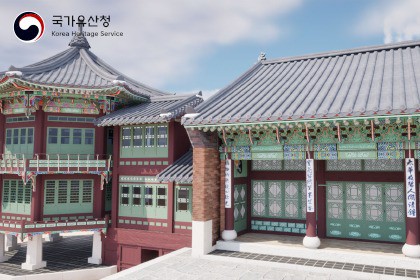
This is components of Korean Gyeongbokgung Palace; three buildings of the Jiboxjae complex.These 3D assets were produced by Korea Heritage Service as a project to build raw resources for the production and supply of Korean heritage digital contents in 2024.For commercial use, you can mark the 'Korea Heritage Service' as the source.Link : KOREA HERITAGE SERVICE [KHS]The Korea Heritage Digital Service is a service that releases various national heritage data, so that companies, regions, and the public can easily find high-quality national heritage data. It is expected to be of great help to the public as well as companies, local governments, universities and research institutes by releasing national heritage data such as 3D data, drawings, photos, reports and videos that are difficult for the public to access.You can easily access the data by using conditional search functions such as designated items, regions, eras and production years, and also can easily check information such as 3D scanned videos and web VR contents provided by Korea Heritage Service through services such as '3D Asset' and 'Theme Contents'.Gyeongbokgung Palace 경복궁Gyeongbokgung Palace, the main palace in the Joseon Dynasty, was built after King Taejo, founder of the Joseon Dynasty. He had the capital moved to Hanyang during the fourth year of his reign (1395). Its name, literally meaning “great fortune,” originated with a phrase of Sigyeong (Book of Songs), quoted by Jeong Do-jeon, an eminent scholar in the Joseon Dynasty: "I've already drunk and have been full with virtue, so I will help you get great fortune in my late year as a man of virtue.”Jibokjae House 집옥재This building looks different than traditional Korean architecture. Jibokjae means ‘place for accumulating treasure.’ Then it means that it is the treasure store of the Joseon royal family. The treasure is books, which some value beyond precious metals and stones. King Gojong dreamed of building a strong and prosperous country and put a lot of effort into learning about the developments of advanced nations. He gathered over 40,000 books about Western science and machine technology. Thus this place came to be called the Royal Library. The books are currently housed at Seoul National University. In addition to its function as a library, Jibokjae was where King Gojong received American and Japanese ambassadors and Austrian emissaries. At that time, these meetings were significant because the Donghak movement was spreading like wildfire throughout Joseon, while on the international scene the Sino-Japanese War was looming. Meetings that discussed the future of Joseon were probably held here.Palujeong Pavilion 팔우정This is a pavilion with an octagonal roof. Although traditional Korean pavilions have no windows and people generally had banquets sitting on the floor, this pavilion has a glass window on the outer wall and the inner space feels like a library. It was made as a personal room, rather than a pavilion for banquets. It is located at the west of Jibokjae, which is linked through a passage.Hyeopgildang Hall 협길당This has the shape of ‘L’. The furnace and chimney suggest that it has an ondol. According to records, King Gojong met five foreign envoys from Japan, the UK, Austria, and others here in 1893, making this a stage of diplomatic activities. The inner space of Hyeopgildang consists of the daecheong floor and rooms, maintaining the features of traditional Korean houses.Features:complex of JibokjaeJibokjaePalujeong PavilionHyeopgildang HallNumber of Unique Meshes: 375Collision: YesVertex Count: 10 - 1,337,579LODs: NoNumber of Materials and Material Instances: 72Number of Textures: 218Texture Resolutions: (32*32, 1024*1024, 2048*2048, 4096*4096, 8192*8192)Supported Development Platforms:Windows: (Yes)Mac: (No)







